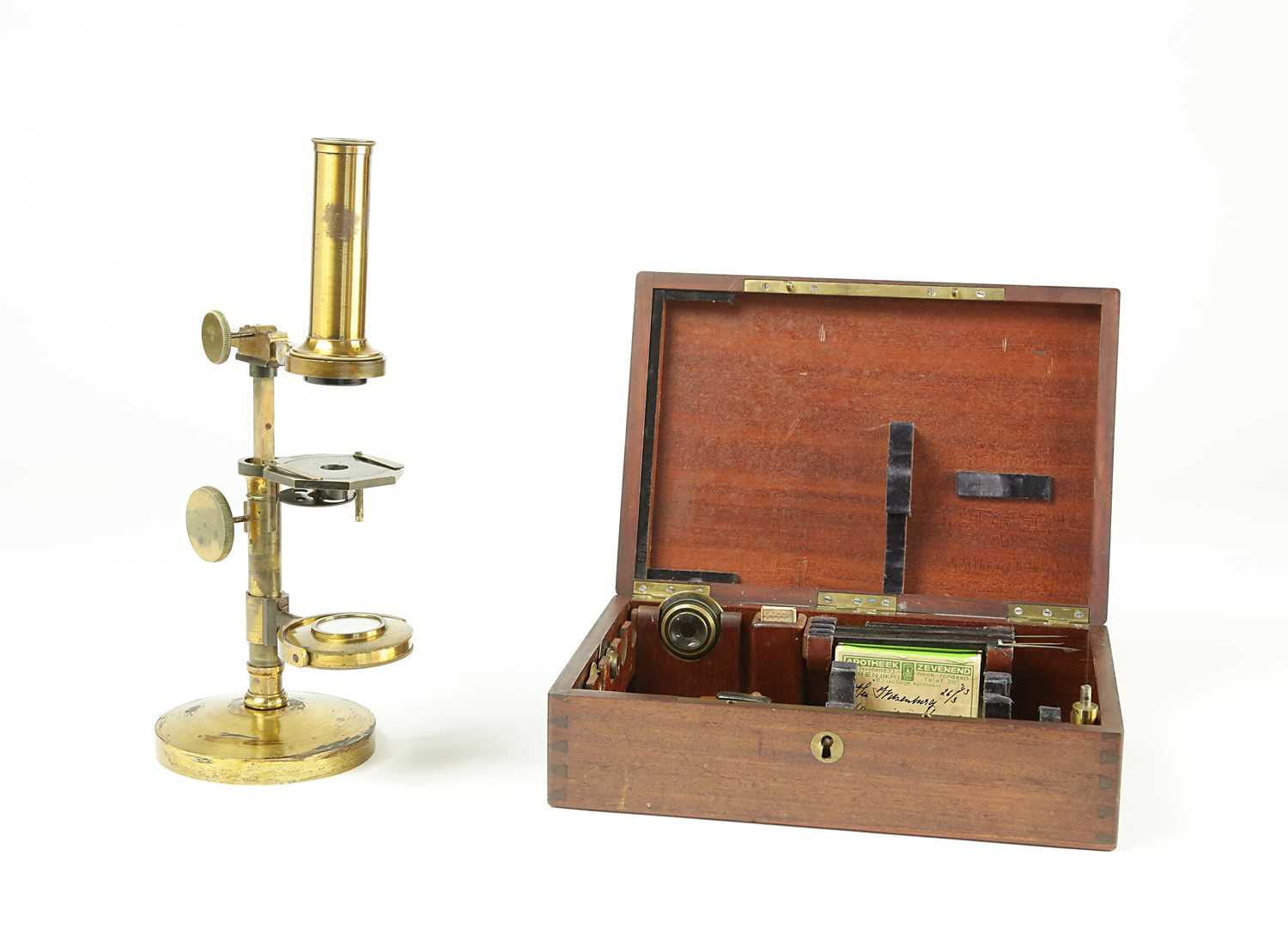1st May, 2000 12:00
Instruments of Science and Technology
93
A Rare Universal Compound Microscope, By Charles Chevalier, Ca. 1840.
A Universal Compound Microscope, By Charles Chevalier.
Paris, France, circa 1840.
Marked “Charles Chevalier, Palais National 158, Paris”, to the gimballed mirror attached to the limb, attached to a round base, with rack and pinion, and octagonal stage with substage aperture disc, in associated mahogany case, with slides and additional objectives.
Measurement: H. 30 cm.
catalogue Note: Charles Louis Chevalier was born on April 19,1804 in Paris, France. He was born in the family of the famous optician Vincent Jacques-Louis-Chevalier (1770–1841) - the owner and head of an optical company founded in 1760.
The company of Vincent (the father of Charles) and Charles Chevalier was famous for the achromatic lenses which were invented by father Vincent, and the lens/prism optics they both had invented for camera obscuras.
In 1825, the cousin of Nicéphore Niépce came to the Chevaliers to buy achromatic lenses for his experimental cameras. He told the Chevaliers about his cousin's first efforts to achieve persisting photographs. That was when Louis Jacques Mandé Daguerre just got interested in similar experiments. Later Charles Chevalier gave him the address of Niépce, the first step for Daguerre to become a photography inventor himself. Chevalier also supplied Daguerre with photographic apparatuses and counseled him in his experiments. In 1828 Charles Chevalier provided Niepce with two new lenses and in 1834 made a lens for astronomical use which he adapted to his camera, "the Photograph," in 1840.
In 1832 Charles founded his own company. The manufacturer's early cameras consisted of two boxes, but in 1840 he introduced a wooden folding camera. Later productions included a problematic Megascope (1838), a lens with changeable front element (1844) and a complete daguerreotype-making outfit (1840). In 1840 he also made photomicrographs on daguerreotypes, and one of his last cameras was used for topographic photography. Also, at that time (in 1840) Chevalier made the first kind of folding camera, the Le Photograph, a whole-plate box camera that was collapsible to parcel size. Charles Chevalier developed a new doublet lens for cameras, with focal lens 29cm and aperture f/5.6, six times faster than the lenses he had made for the first daguerreotype cameras. In 1841 he reunited with father Vincent Chevalier's company. Together they and later Charles' son Louis Marie Arthur Chevalier successfully produced microscopes, glasses and other optical instruments.
Estimate: 400-600
Sold for €1,950
A Universal Compound Microscope, By Charles Chevalier.
Paris, France, circa 1840.
Marked “Charles Chevalier, Palais National 158, Paris”, to the gimballed mirror attached to the limb, attached to a round base, with rack and pinion, and octagonal stage with substage aperture disc, in associated mahogany case, with slides and additional objectives.
Measurement: H. 30 cm.
catalogue Note: Charles Louis Chevalier was born on April 19,1804 in Paris, France. He was born in the family of the famous optician Vincent Jacques-Louis-Chevalier (1770–1841) - the owner and head of an optical company founded in 1760.
The company of Vincent (the father of Charles) and Charles Chevalier was famous for the achromatic lenses which were invented by father Vincent, and the lens/prism optics they both had invented for camera obscuras.
In 1825, the cousin of Nicéphore Niépce came to the Chevaliers to buy achromatic lenses for his experimental cameras. He told the Chevaliers about his cousin's first efforts to achieve persisting photographs. That was when Louis Jacques Mandé Daguerre just got interested in similar experiments. Later Charles Chevalier gave him the address of Niépce, the first step for Daguerre to become a photography inventor himself. Chevalier also supplied Daguerre with photographic apparatuses and counseled him in his experiments. In 1828 Charles Chevalier provided Niepce with two new lenses and in 1834 made a lens for astronomical use which he adapted to his camera, "the Photograph," in 1840.
In 1832 Charles founded his own company. The manufacturer's early cameras consisted of two boxes, but in 1840 he introduced a wooden folding camera. Later productions included a problematic Megascope (1838), a lens with changeable front element (1844) and a complete daguerreotype-making outfit (1840). In 1840 he also made photomicrographs on daguerreotypes, and one of his last cameras was used for topographic photography. Also, at that time (in 1840) Chevalier made the first kind of folding camera, the Le Photograph, a whole-plate box camera that was collapsible to parcel size. Charles Chevalier developed a new doublet lens for cameras, with focal lens 29cm and aperture f/5.6, six times faster than the lenses he had made for the first daguerreotype cameras. In 1841 he reunited with father Vincent Chevalier's company. Together they and later Charles' son Louis Marie Arthur Chevalier successfully produced microscopes, glasses and other optical instruments.
Estimate: 400-600
Auction: Instruments of Science and Technology, 1st May, 2000
Hessink's proudly presents the sale of a fine single owner collection of Instruments of Science and Technology. The sale offers you a great opportunity to purchase beautiful selection of globes, microscopes, telescopes, medical, drawing, surveying and navigational instruments from famous instrument makersfrom the 17th to the 20th century.
